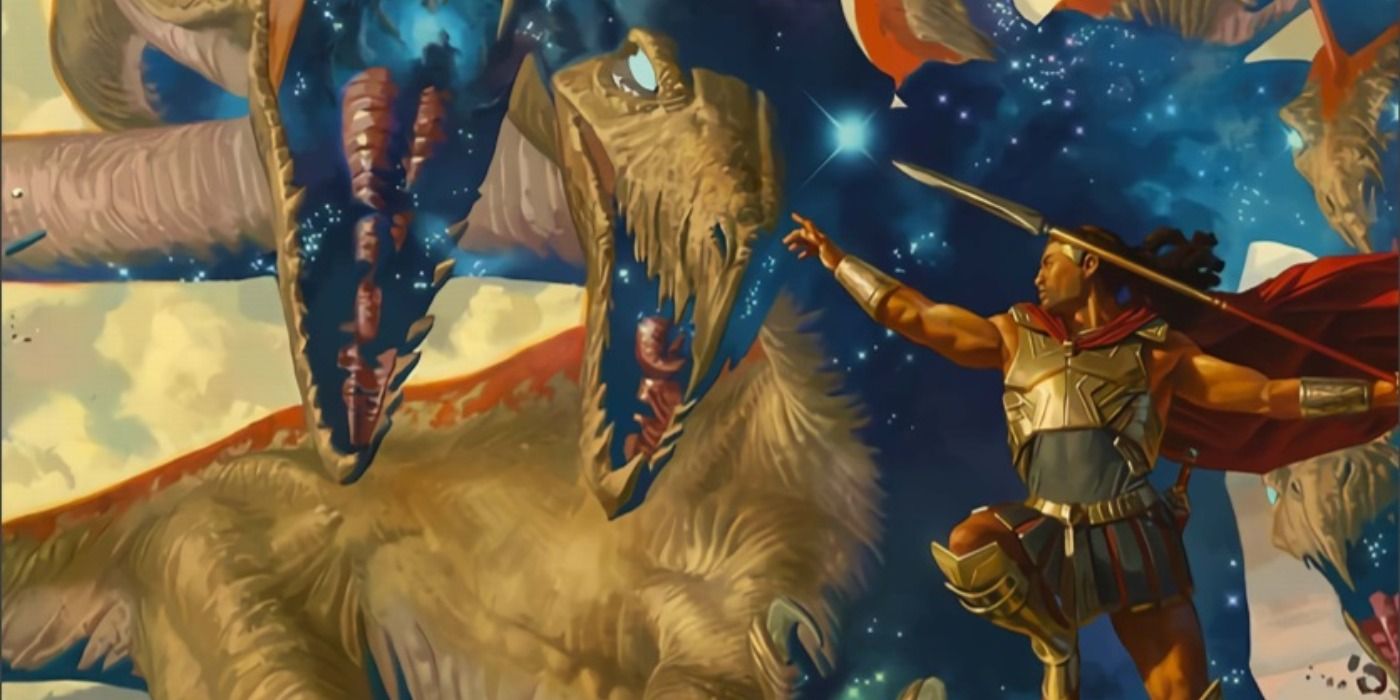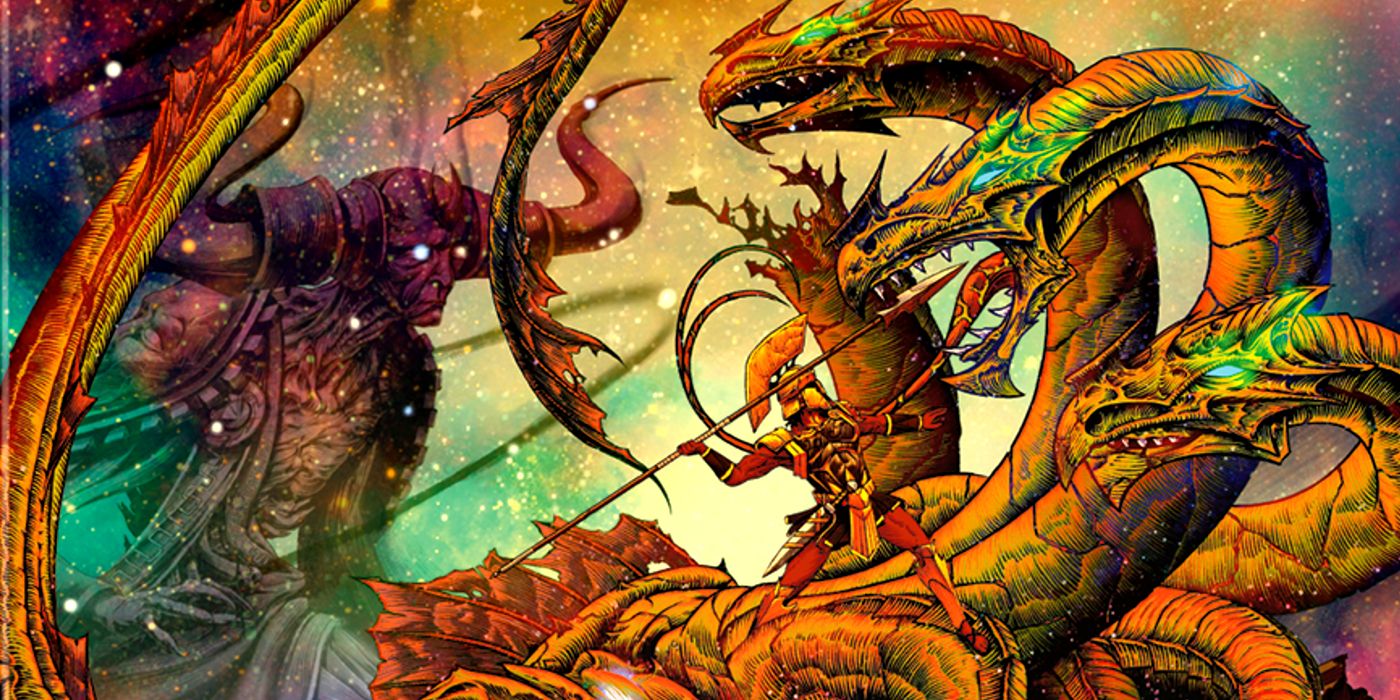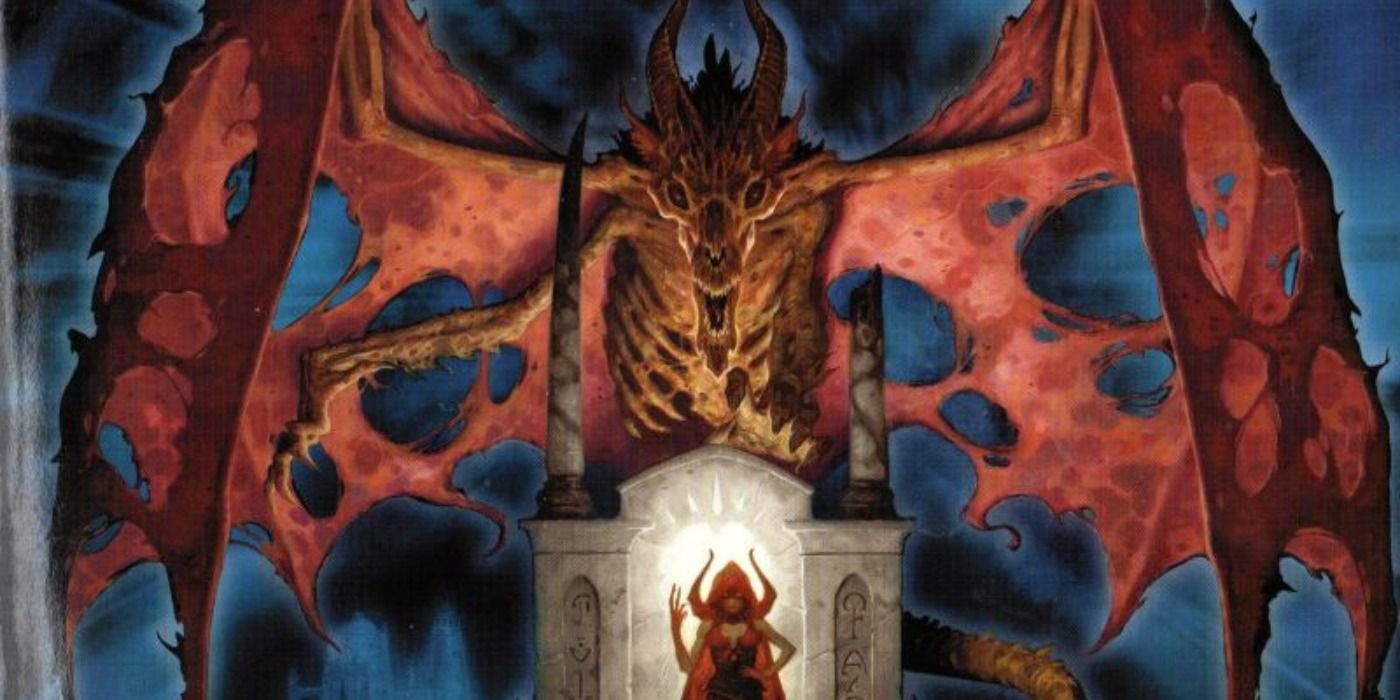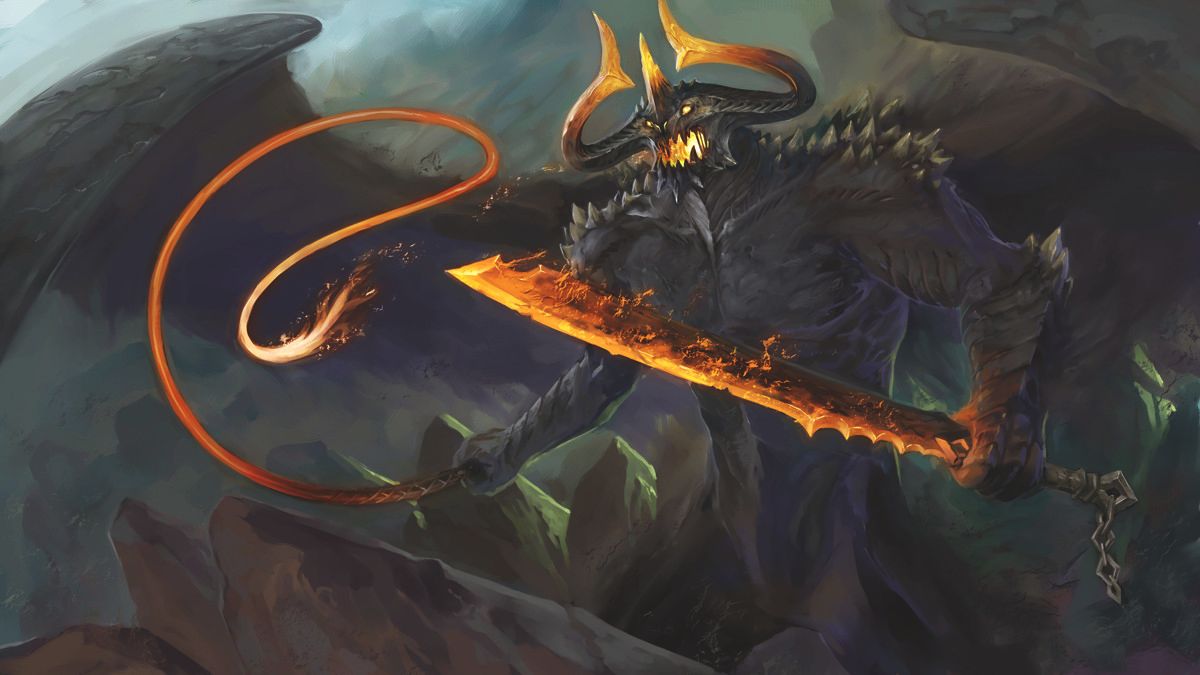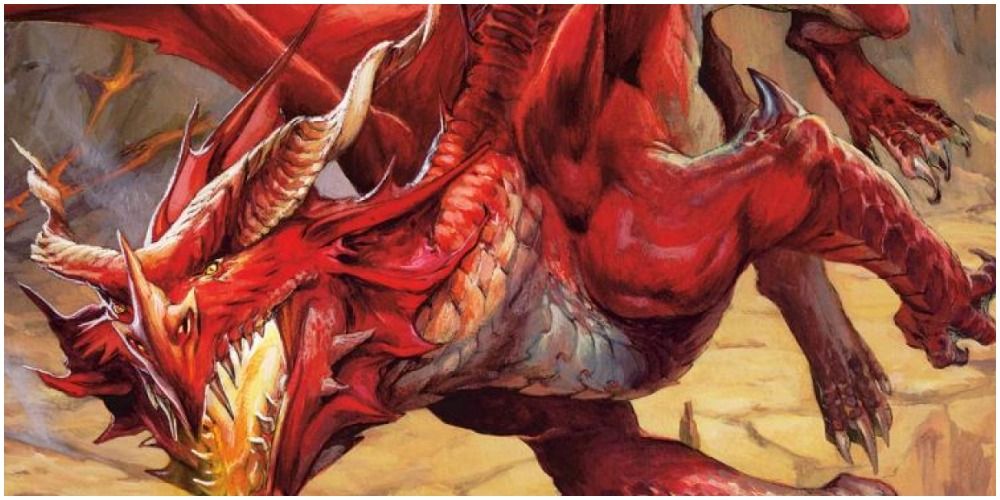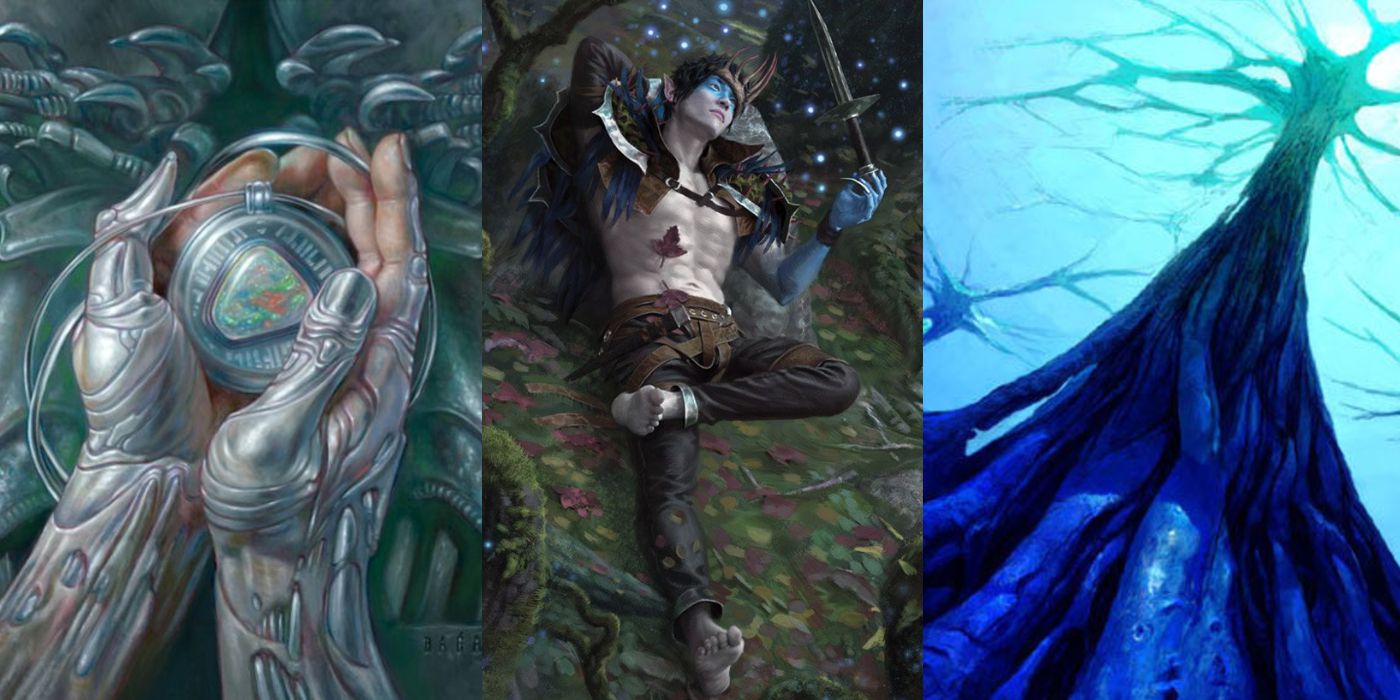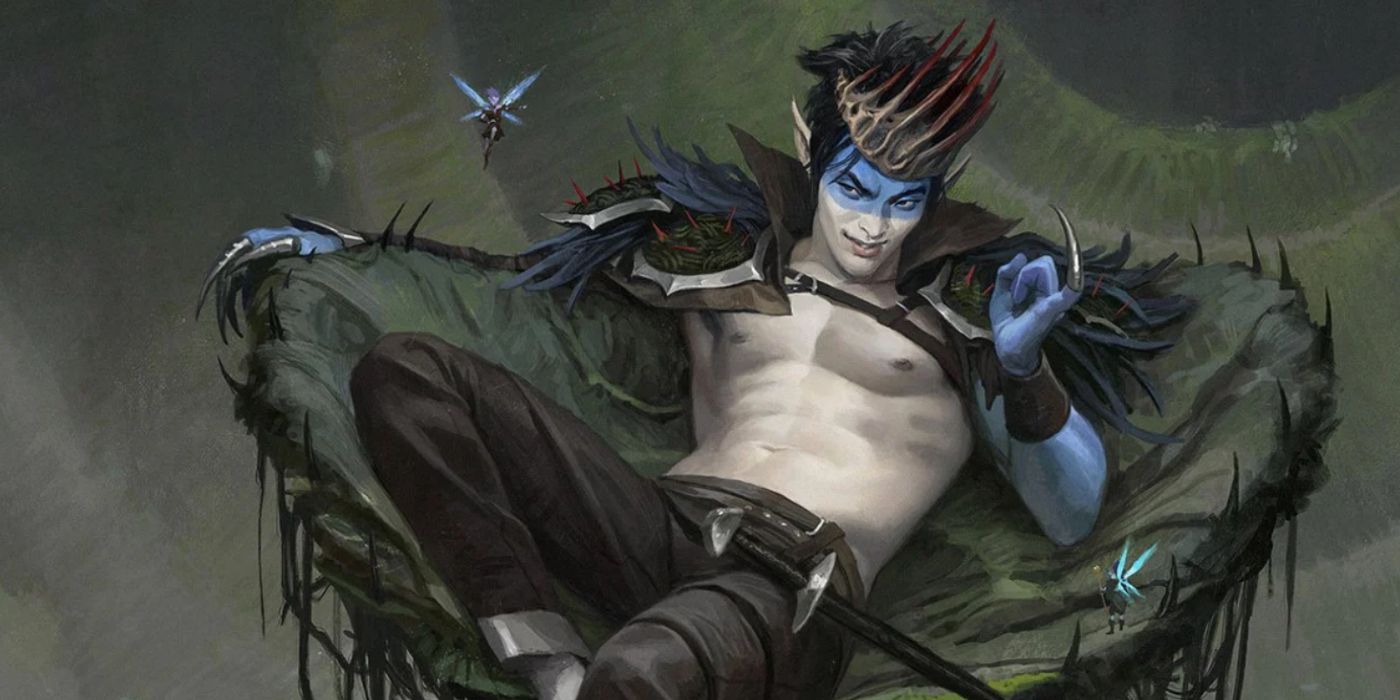The worlds of Dungeons & Dragons and Magic: The Gathering have come together once more in the latest book for the tabletop RPG.
Mythic Odysseys of Theros is a new D&D sourcebook that adapts the realm of Theros from Magic into a campaign setting. Theros is heavily inspired by Ancient Greece, which means that it's a land where heroes battling monsters and gods interacting with mortals is a normal event.
Screen Rant recently spoke to writers James Wyatt and F. Wesley Schneider about the content in the Mythic Odysseys of Theros, as they were tasked with bringing one of the most intense Magic settings to the world of Dungeons & Dragons.
Theros is a departure from the campaign worlds that D&D players might be familiar with, as it’s heavily inspired by Ancient Greece. So, could you tell us a little bit about Theros and what players can expect in the book?
James Wyatt - Theros is a world that is inspired by Greek myths from the Magic: The Gathering world-building perspective. It was an effort to build a world from the ground up, as a fantasy world informed by mythic themes. Our job was to take that world and translate it to D&D, which means keeping a lot of the world-building intact but also fleshing it out to make it a more comprehensive setting for D&D players to explore.
Wesley Schneider - One of the other big elements of this is that in all of your favorite classical mythology stories, the gods are always right there, they're always meddling, they're always setting up plots, they're always getting engaged in the schemes of their favorite heroes and villains. From a D&D perspective, you have that to a degree with the various D&D pantheons, where you've got clerics and paladins and all sorts of characters who might be involved with the gods, as part of their character, but in Theros, the gods are very much interested in you, they're coming for you, you are their focus. So everybody has the potential to have some engagement with the deities who are right there being active players in the world, potentially guiding you whether you are a cleric, a paladin, a rogue, or a fighter.
The monsters of Greek mythology are a big part of D&D, but they’re usually transplanted into worlds based on European medieval fantasy settings. How are creatures like gorgons and krakens different in Theros when compared to other D&D settings?
James Wyatt - There is some discussion in the book about using the Greek-inspired monsters in the Monster Manual as they appear in Theros and there are some unique versions of things like hydras and krakens and gorgons as well. Including the legendary Gorgon Hythonia the Cruel who gets the Mythic monster treatment, as well as Tromokratis the kraken and Araste of the Endless Web. These Mythic monsters were our effort to apply the idea of mythic storytelling to our monster designs and say "OK" so when you encounter THE gorgon, THE medusa, or Hythonia the Cruel, it's not just one more monster on the series of questing through the dungeon. It's really an adventure in itself, an encounter that's more like a boss battle in a video game.
Wesley Schneider - There is also certain monsters that you see come up again in the Monster Manual, where they're sort of stock. Like, the hydra for example. It's a CR 8 monster, so when we put a hydra on the cover of the book, it's like "we might need to give that a little bit of lift" if it's going to be "Woo the excitement of eighth level adventuring" right there on the cover. So we've even got updated and revised takes for some of the monsters that you've seen again and again. Hydras, for example, you get the Ironscale Hydra in here that is way more buff, but you've also got the Legendary Hydra Polukranos, who is at Challenge Rating 19. But then you've also got minotaurs and whatnot, where in addition to being foes that you can encounter, you can also play. So you have the opportunity to explore that side of mythology, and in this case from the sides of one of classical mythology's most iconic monsters.
Theros is adding new playable races to D&D, one of which is centaurs. Can small characters ride centaur characters and use them as mounts in battle?
Wesley Schneider - I think so
James Wyatt - Yeah, I think so
Can a Cavalier player use another centaur player as their mount and apply their class abilities to them?
Wesley Schneider - Totally follow your bliss, if both parties are consenting adults and they want to do this.
Supernatural Gifts give players extra abilities starting from level one, some of them making it harder for characters to die. Do these affect the Challenge rating system that already exists in the game? Will a group with supernatural gifts steamroll creatures from existing books?
James Wyatt - I think the DMs will pretty quickly learn to adjust as needed. I'm not sure huge adjustments are needed. Characters tend to steamroll over monsters more or less anyway with not a lot in the way of fatality. If avoiding fatalities is the biggest benefit of a gift, the impact is not going to be that huge.
Wesley Schneider - They are also the opposite side of this, in that so many supernatural gifts, while they may be a little bit of a bump, a little bit of a boost that all of the players in the group get. They're so drenched in the story of the world that, yes, you might get a little extra resilience, but so many of them are like "You are an oracle of a specific diety, you get this insight" or "You are the reincarnation of a legendary hero", you have this background. They end up being deeply story-rich, but also, in many cases, and we don't say it right there at the upfront, but they really get you embroiled with some of the tangled plots of the world. So yeah, you can take it, yeah you might get a little bit of a boost, but you're gonna freaking need it because now you're in the mix.
By the same token, are the new playable races in Theros equally okay to use for campaigns written before the book was released? Some of the new races possess some pretty powerful abilities compared to the ones in the Player’s Handbook, and they feel as if they are designed for more high-powered campaigns than ones released in the past.
James Wyatt - I think they work fine in any setting, in fact, the centaur and the minotaur previously appeared in the Guildmaster's Guide To Ravnica and the triton was originally from Volo's Guide to Monsters. So, I don't think they're vastly out of line with what we've seen elsewhere.
Wesley Schneider - All of the design work goes through the exact same rules team that any D&D book goes through. The exact same people are vetting them, the same internal (and sometimes external) playtest process, and everything is being considered on the same baseline. So if something does seem a little more powerful than usual or something does seem like "that looks real good", that might speak more to like "Ooh this is the thing for me, I'm excited about this" and less about some kind of creep.
Theros adds some magical slings & sling ammo to the game. Was there ever an intention to overhaul the basic version of the sling for the book? A lot of players feel that the base version of the sling from the Player’s Handbook is pretty weak.
James Wyatt - There was definitely an intention to offer some magic options to make the sling more attractive, but revamping it is not a high priority.
Wesley Schneider - It's pretty funny because we have a few folks on staff who are actually sling enthusiasts, like, actually have slings at their desks. There are a few nice rocky beaches not far from the office and whatnot, so when the opportunity came up, it was "Oh we have some thoughts about slings" Ok, well, do we have the column of magic item space for you.
James Wyatt - It's actually really funny because I questioned why those magic slings were in there because they're not from the Theros card sets in any way. But you're right, this was identified as a spot to give some love to the sling.
The rules for Piety were already in the Dungeon Master’s Guide, but they only consisted of a few paragraphs and were poorly defined. How are the Piety rules expanded in Theros?
James Wyatt - The basic rules remain the same. You have a piety score that the DM controls. What the Theros book does is give more concrete guidelines for what conditions the DM might use to judge whether your piety score increases or decreases and then gives concrete benefits for each of the fifteen gods of Theros.
Gods and Piety are a big part of Theros. The older editions of D&D used to be very in your face with how the gods reacted to mortals, especially in the novels. The later editions pulled this back and made the gods more distant and less involved with the affairs of mortals. How will this work in Theros? Are gods a common sight in this world?
James Wyatt - They are literally a common sight in that they appear in the night sky as constellations, or sometimes more concretely. The art of them in the card game shows them striding across the horizon, with this enormous scale. There is definitely a sense in this world that they do tangibly appear to mortals, as well as sending omens or speaking through statues or most often speaking through oracles. There is a sort of immediacy to them, but, there are no stat blocks for gods. We don't anticipate characters confronting them at any point in the game.
Wesley Schneider - But there is a section where you can literally go to Nyx. You can go to their house and be like "Purphoros, I'm calling you out, I want a quest, I want... bring it on" and the deities can set you up with your own specific customized epic journey mission from the god's themselves, for fabulous prizes of course.
In ancient Greek mythology, gods would often intervene directly and change the outcome of events. Is this something that also happens a lot in Theros and is it something players can reliably try and call upon without being clerics?
James Wyatt - There is nothing reliable about the gods (laughs) that plea is absolutely something that characters can do and it's really in the DMs hands as to how they want to handle it. The section that Wes was just referencing about divine ordeals, it's actually a very involved process, in order to get to Nyx (leaving aside the question of spells like plane shift), you have to undergo a journey. The mythic feel there is quite intentional. We want it to feel like you are setting out on a journey of a lifetime. It's entirely up to the DM to set what the terms of the ordeal are. There are also some guidelines in there for the DM on divine intervention on how to handle it, how to not take player agency away. Don't make it too hard or don't make it too easy, which is kind of DM advice 101, or the ultimate challenge of every dungeon master, trying to find that line. We try to talk the DM through some of the issues involved there. The presence of the gods should never make heroes unnecessary or diminish their heroism.
Wesley Schneider - It needs to be a springboard to adventures. Yeah, you might treat a god to come and help you, but now you owe a god a favor and they've got way better imaginations and perspectives than you do.
Theros is adding two new subclasses - the College of Eloquence for bards and Oath of Glory for paladins. How do these subclasses work?
Wesley Schneider - So the College of Eloquence is very much set up to let you indulge that fantasy you always wanted to be a greek orator, to stand in front of your audience and just dazzle them with the beauty of your words or the irrefutability of your logic. So, this is the bard who wants to be the talker, who wants to be the speaker, instruments aside - you will listen to the sound of my voice. Just to rattle off a few of the titles here for different features - Unsettling Words, Silver Tongue, Unfailing Inspiration, Universal Speech is one I really enjoy, you get to the point where language barriers will not save you. And this really interesting Infectious Inspiration ability allows you to pass around your inspiration between the entire group. On the other side of the spread, is the paladin Oath of Glory. This is a character who even moreso from many of the heroes of Theros knows from the word go that they are destined for greatness, that they have a destiny, a path that they know they are going to do incredible things. They're going to bring all of their best friends along for the experience. So, this is the paladin that leans into big feats of athleticism, being you're classical Greek hero. And then they get the ability Peerless Athlete, for example, it allows you to boost up your athleticism. A lot of elements that feel really good for the battlefield in working with the group to make sure that everybody is defended, or able to push at the same time.
James Wyatt - There's a larger than life boastiness to them that I really like. It's a very different feel of the paladin, not so much a medieval warrior of chivalry, but that big brash boasty warrior on the Greek battlefield.
One of the most highly anticipated parts of Theros is the Mythic rules for monsters, which allow enemies to transform when certain conditions are met. I have to ask… was this rule inspired by video games? It feels very Final Fantasy if you don’t mind me saying.
Wesley Schneider - To a degree yes, where we see this again and again. I've seen it attempted several times where you get the experience you so often see in video games and movies, where it's like "It's the big monster, you have the dramatic fight and... oh no, it's revealing its true form". That sort of element.
James Wyatt - Just when you think you got it, that dramatic turn is a key part of it.
Wesley Schneider - That's something that I think as DMs, many of us have pulled off at the table, but always quantifying that has been a little bit of a trick. When we took a run at it this time, not only did we lean into "let's do big stat blocks" and really make these feel like huge epic encounters. This was an opportunity to pull in something that we see in adventures all the time, like read-aloud text, where it's like "OK, when thing X happens, read this text because this is the transformation part". This is the element where everything turns, and hopefully, the hope is that when folks are playing it at the table, when they're like "OK, we killed the big monster" and the DM actually opens up the book and starts reading the next thing, folks are going to be like "I thought we won?"
James Wyatt - I think the design team did a great job pulling that off. Working within the existing rule structure using Legendary Actions and then in the second phase of the encounter, the monster gets access to additional Legendary Actions that will actually become more dangerous. The math behind it is beautiful and weird, it works out to be a lot like you're fighting two monsters of the same challenge level. But instead of "OK we're fighting two monsters and then we kill one and the encounter becomes slightly less dangerous and then we kill the second one". It's like you're fighting one monster and then you kill one and then suddenly it's more dangerous and you're fighting two of them. And the Legendary Actions are what makes that work. It's pretty cool.
We know at least one Mythic monster is planned for Icewind Dale: Rime of the Frostmaiden – can we expect to see more of them in future campaigns? Will it be the recurring element of every D&D end boss going forward?
Wesley Schneider - You know, it's been funny. When we put this together, the intention was like "We'll try it out, we've got this great opportunity here, we'll see how folks like it". We have definitely had designers who are working on other projects being like "Ooo this could be a Mythic monster" or "We could probably make that one a Mythic monster" or so on. The book's not even out yet, let's see how folks like it. There is definitely some interest inside the house, but ultimately it's going to depend on how folks dig it. I'm hearing from at least one person here that they like it so far, but overall, if we continue to get the feedback that folks are enjoying this and it's working in their games then that's an experience they want, we're always listening.
Theros is based on a plane from Magic: The Gathering – how did you decide which elements from the card game made it into D&D and were any ideas cut during development?
James Wyatt - I think the process was more additive than anything else, we took the world guides that were created for Theros for the card sets and expanded those to flesh it out. I think of Magic worldbuilding like building a movie set. The old fashioned stereotype of the movie set where you walk down the streets of the town in the western and it's just a facade and there are no actual buildings behind them. The Magic team is very good at creating the illusion that there is a world beyond those walls, but D&D players need to be able to go there, in ways that the card set doesn't. So, we did a lot of fleshing out. I mean, like the bestiary chapter is largely a question of filtering all of these monsters that appeared on the cards and deciding which ones needed to be reflected in the book. The answer is a lot of them. But I can't think of anything we decided to leave out.
Wesley Schneider - No, not really. It's so much in Magic that you have this cool monster, you have this cool monster, and now they fight. In D&D, so much of the storytelling is you have this cool monster and you have this cool monster and now they're friends. So, it did involve some re-concepting in groups like the minotaurs or the leonin for example, where so often they are presented as foes or challenges or what have you. A lot of our work involved - we've got all of this fantastic art, all this great context, all this suggestion of culture, let's start putting together these beats and revealing what the story is behind that. As much as you expect to have the leonin hunters or the minotaur warriors, let's also be able to tell the story about the minotaur wizards or the leonin bakers. I mean, we want the whole culture to be there and feel alive. Magic gives us a fantastic springboard for that, so it was just a matter of doing the gymnastics after that.
Did you receive any help from the Magic: The Gathering team while working on the book?
James Wyatt - I was basically the Magic team helper, along with two of the folks who used to work on the Magic team and who worked on past incarnations of Theros are now on the D&D team - Adam Lee and Ari Levitch. So they also contributed to the book. The Magic franchise team was responsible for keeping track of Magic worlds beyond the card set, they did a review of the book and had one of their experts do a pass over it as well. The two halves of the company are closer than they have been at times in the past.
Wesley Schneider - I'm the one who came into this knowing nothing about Theros. I am not a Magic player, I love the art, when we both started talking about this, we were super excited for the project, super excited for all of the thematic elements and whatnot. From the get-go "we can build something cool here...Oh, there's a world already, do we have any information about... oh we do!" I guess I have to get up to speed.
Did you try to represent any of the game mechanics from Magic: The Gathering in Theros?
James Wyatt - Our fundamental goal was to let you play D&D in this Magic world, not to try to simulate playing Magic at the D&D table. That's the philosophy. I've been doing Magic/D&D crossovers, partly on my own time and partly with the Ravnica book for six years now. We put out a series of PDFs for each new world that Magic released, presenting them as D&D settings and that has been my guiding philosophy. D&D players want to play D&D, so I'm giving you the tools you need to play D&D in this cool world, not trying to simulate the mana system from Magic in D&D, which I've played around with and it's weird. I guess the one nod in that direction maybe is the Piety system because Devotion was a really important mechanic in the Theros card sets. That's really more of a reflection... here is a fact of the world - the god's matter. Here is how it's reflected in Magic mechanics in Devotion and here's how it's reflected in D&D mechanics with Piety, rather than translating mechanics in any way.
Are they any plans to adapt more Magic planes to D&D?
James Wyatt - We don't have any plans at this point.
If given the choice, which Magic plane would you like to adapt next?
James Wyatt - If it were entirely up to me... I would love someday to take the very first of these Plane Shift PDFs that I wrote, the Plane Shift Zendikar, and blow that out into a campaign setting. Zendikar from the getgo was a very D&D flavored world and the internal catchphrase we used for it was "Adventure World", and it's got diverse races and adventuring parties going out into the world and I would love to expand that. We have a new Zendikar setting coming out this fall, who knows... maybe I'll sit down in front of the TV in the evenings and do a revised version of its Plane Shift.
Wesley Schneider - As much as my inner (which is also mostly my outer) spooky boy really wants to say Innistrad, um... I dunno, after Ikoria earlier in the year... if folks like these Mythic monsters, that would be a good place for it. And hey, who knows, maybe we could finally get real D&D stats for Godzilla.
How do God Weapons work exactly? Are they intended to be standard rewards (like regular magic items)? Can they throw off the game balance?
James Wyatt - They're presented as artifacts, with all of the caveats that come with using artifacts in your game as they're presented in the Dungeon Master's Guide. The one really distinctive thing about them is... a brilliant take on existing mechanics, is the way that the design team linked the random properties of artifacts with the piety of the person wielding it. So, if you're a devoted servant of Heliod, his spear is more powerful in your hands than if you're not. It's really simple, it takes like three sentences to write, but is super effective at conveying that flavor. But otherwise, they work just like regular artifacts. Which is to say they're crazy and will wreck your game. (They won't wreck your game). They will have a significant impact on your game.
Wesley Schneider - This has been another rules concept that I feel like we've seen runs taken at before, where it's like "the magic item that levels up over time", but this was a perfect opportunity for, like, through your adventures, through your piety, through your growing relationship with your diety. The powers of your artifact get increased over time, so it's really fun, I look forward to seeing how folks like using them.
How exactly do you go about stealing a weapon from a god? I remember Deities & Demigods and it seems like they’d be pretty hard to steal.
James Wyatt - There is a story from the original Theros block, part of the web fiction that came out with the set that involved the Planeswalker Kiora stealing the Bident of Thassa, which she then brought back to Zendikar with her to fight the Eldrazi. The promotional material is a reference to that. That's entirely in the DM's hands how to make that happen. You would want to build an adventure around that.
Wesley Schneider - And I feel like a staple that since all of the gods in their sections have these, like, pretty significant lists of types of heroes, types of villains, types of adventures. A pretty common trope that comes up among these is "Oh they just happened to leave their super-powerful weapon lying around" or in a battle, you ended up having this weapon land over here, recover it, take it back from somebody. There will be things throughout the book that suggest those directions.
Now that the Theros campaign book is released, are there any intentions to release any more books using the setting? Could we expect to see a full campaign in the vein of Curse of Strahd or Icewind Dale: Rime of the Frostmaiden based on ancient Greek epics set in Theros in the future?
James Wyatt - I think we're seeing some of that coming out of the Dungeon Master's Guild already. I can't speak to the plans of the D&D team, but I'm pretty sure that they're moving on to other worlds and other adventure stories.
Wesley Schneider - This is one of those boring times where it's like "We have not made any announcements to that". But we would be fools to be like "Oh, folks are super excited about Theros, let's not give them anything else". If folks tell us like "Yeah we wanna see adventures here, we wanna see more here, more more, more, more". Like I said, we're always listening, we want to make sure that we're building a game that's not just for us, but for the whole community. So yeah, if folks want to see Theros adventures, let us know. We'll throw it in the hopper will all of the other schemes.
Yeah, Theros feels to me like it would be a great setting for a high-powered campaign where you can just go crazy with high-level gear and powers and not have to worry too much about keeping things on a level playing field.
Wesley Schneider - Absolutely.
The Mythic Odysseys Of Theros sourcebook for Dungeons & Dragons is available now.

